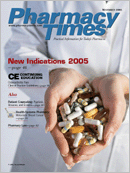Publication
Article
Pharmacy Times
A Pharmacist's Guide to OTC Therapy: Antifungals for Nails
Author(s):
Tinea unguium, also referred to as onychomycosis, is a fungal infection of the nails. Onychomycosis causes fingernails or toenails to thicken, discolor, disfigure, and split.1 More than 2.5 million individuals in the United States are treated annually for tinea unguium. Because many cases go untreated, however, the incidence is probably much higher.2 In ~80% of fungal-infection cases, the toenails are most commonly affected.3 Some predisposing factors are shown in Table 1.
Nails affected by tinea unguium gradually lose their normal shiny appearance and can become opaque. Common signs and symptoms of nail infections may include the following:
- Flat or dull nails
- Thickened nails
- Brittle nails that may be distorted in shape
- Discoloration of the nails
- Pain or redness around the area of the nail
- Nail separated from the nail bed
Treatment
Individuals with signs and symptoms of tinea unguium always should be referred to their primary health care provider for further assessment and treatment. Onychomycosis cannot be effectively managed only with the use of topical nonprescription agents. Prescription agents, such as terbinafine hydrochloride and itraconazole, must be used to treat this type of infection, and, in some cases, surgical removal of the nail is required. Nonprescription agents sometimes can be used in conjunction with prescribed systemic agents to reduce nail discoloration and smooth out thick or rough nails (Table 2). It is imperative that pharmacists remind patients that therapy is usually long-term and compliance is essential for effective treatment.
Some studies have shown that the use of complementary agents, such as 100% tea tree oil topically for at least 6 months, can aid in eradicating some fungal infections.2
Ms. Terrie is a clinical pharmacy writer based in the northern Virginia area.
For a list of references, send a stamped, self-addressed envelope to: References Department, Attn. A. Stahl, Pharmacy Times, 241 Forsgate Drive, Jamesburg, NJ 08831; or send an e-mail request to: [email protected].

Newsletter
Stay informed on drug updates, treatment guidelines, and pharmacy practice trends—subscribe to Pharmacy Times for weekly clinical insights.






